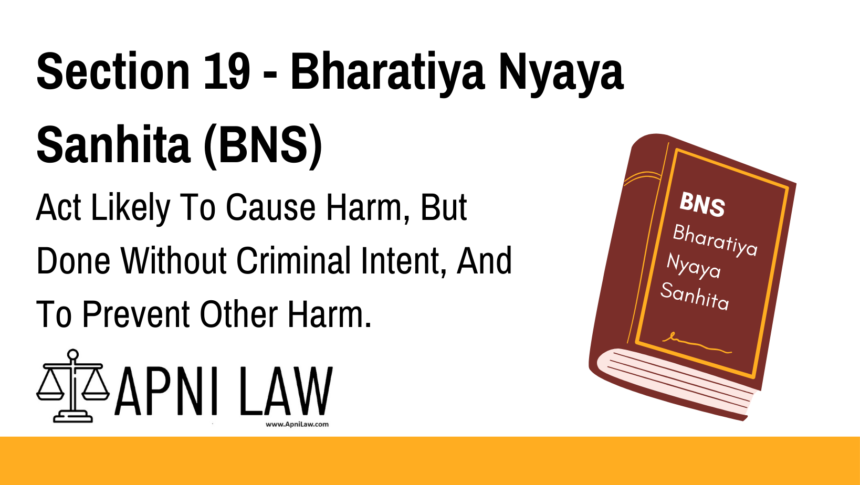Code: Section 19 BNS
Nothing is an offence merely by reason of its being done with the knowledge that
it is likely to cause harm, if it be done without any criminal intention to cause harm, and in
good faith for the purpose of preventing or avoiding other harm to person or property.
Explanation.—It is a question of fact in such a case whether the harm to be prevented
or avoided was of such a nature and so imminent as to justify or excuse the risk of doing the
act with the knowledge that it was likely to cause harm.
Illustrations.
(a) A, the captain of a vessel, suddenly and without any fault or negligence on his
part, finds himself in such a position that, before he can stop his vessel, he must inevitably
run down a boat B, with twenty or thirty passengers on board, unless he changes the course
of his vessel, and that, by changing his course, he must incur risk of running down a boat C
with only two passengers on board, which he may possibly clear. Here, if A alters his course
without any intention to run down the boat C and in good faith for the purpose of avoiding
the danger to the passengers in the boat B, he is not guilty of an offence, though he may run
down the boat C by doing an act which he knew was likely to cause that effect, if it be found
as a matter of fact that the danger which he intended to avoid was such as to excuse him in
incurring the risk of running down the boat C.
(b) A, in a great fire, pulls down houses in order to prevent the conflagration from
spreading. He does this with the intention in good faith of saving human life or property.
Here, if it be found that the harm to be prevented was of such a nature and so imminent as to
excuse A’s act, A is not guilty of the offence.
Explanation of Section 19 BNS
1. Purpose & Scope
This section provides legal protection when:
✅ An act is done with knowledge that it may cause harm
✅ The act is done without criminal intent
✅ The purpose is to prevent greater harm
✅ The action is taken in good faith
2. Key Conditions for Protection
- The harm must be unintended.
- The act should be done only to prevent a more serious danger.
- The proportionality of harm is considered—was the greater harm serious enough to justify the lesser harm?
- The person must act in good faith.
Illustration & Examples
Example 1: Emergency Medical Action
A doctor amputates a patient’s leg to stop a deadly infection from spreading. Even though this causes harm, it is done in good faith to save the patient’s life—hence, no offence is committed.
Example 2: Breaking Traffic Rules in an Emergency
B, an ambulance driver, runs a red light while rushing a critical patient to the hospital. Even though he knew it was risky, he acted without criminal intent to save a life—so he is not guilty.
Example 3: Destroying Property to Prevent Greater Loss
During a flood, authorities break a dam wall to divert water away from a city. Some areas get flooded, but the action prevents a much bigger disaster. Since the decision was made in good faith, it is not an offence.
Common Questions & Answers on Section 19 BNS
1. What is the key principle behind Section 19 BNS?
The law allows lesser harm if it is done in good faith to prevent greater harm. However, it must be justifiable based on the situation.
2. Can Section 19 BNS be misused as a defense?
Courts carefully examine intent and necessity. If a person could have prevented the harm differently but still caused damage, this section may not apply.
3. How does Section 19 BNS differ from Section 18 BNS?
- Section 18 BNS covers accidental harm during a lawful act.
- Section 19 BNS applies when harm is knowingly risked, but only to prevent a bigger harm.
4. Is this section applicable in cases of property damage?
Yes, if damage is caused to save lives or prevent a bigger disaster, Section 19 can protect the person from liability.
5. How does this relate to the “Doctrine of Necessity” in law?
This section follows the Doctrine of Necessity, which allows breaking a law to prevent a greater danger—but only if the act was unavoidable and proportionate.
Conclusion
Section 19 BNS ensures that good faith actions taken to prevent larger harm are not criminalized. However, courts carefully evaluate whether the lesser harm was truly necessary.
For more legal insights, visit ApniLaw today! 🚀








